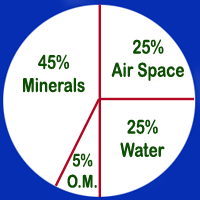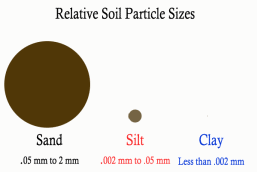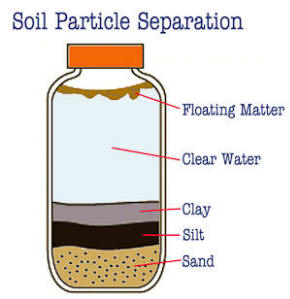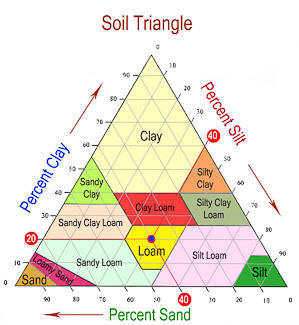|
 |
|
 |
One
of those little "quirks" I have is that I do not like people
calling soil, dirt. I was taught that soil is a
combination of minerals, air, water and organic matter that
has a structure capable of supporting plant life. Dirt is what
you sweep up off the floor. It has no structure and contains
all sorts of unidentified "stuff" that would not help a plant
to grow.
 I have come to the belief
that those people we say have "a green thumb" are really
people
who understand soil. Most of us concentrate on which plants we
want to grow. This is the fun part of gardening which includes
searching through beautifully illustrated
catalogs and
nurseries with fantastic display gardens. It is exciting. I have come to the belief
that those people we say have "a green thumb" are really
people
who understand soil. Most of us concentrate on which plants we
want to grow. This is the fun part of gardening which includes
searching through beautifully illustrated
catalogs and
nurseries with fantastic display gardens. It is exciting.
 The "green thumbers", however, have learned
that they need to devote at least some of their precious time
to the less glamorous task of building their soil. They do not
mind getting their hands and clothes dirty (yes, once it
leaves the garden enmeshed in the knees of your pants, soil
becomes dirt). One way or another, they have learned that in
order to grow good plants, you have to maintain balance in the
soil. The "green thumbers", however, have learned
that they need to devote at least some of their precious time
to the less glamorous task of building their soil. They do not
mind getting their hands and clothes dirty (yes, once it
leaves the garden enmeshed in the knees of your pants, soil
becomes dirt). One way or another, they have learned that in
order to grow good plants, you have to maintain balance in the
soil.
|
|
 |
|
Soil Composition |
 An
ideal soil for landscape plants is generally defined as one that has 25% air
spaces, 25% water, 45% minerals and 5% organic matter. Before
planting anything in the landscape (except trees), we should try to re-establish this ratio in
our soils. After things are planted, we should strive to
maintain this balance of factors by not compacting the soil by
walking on it or driving equipment across the surface. An
ideal soil for landscape plants is generally defined as one that has 25% air
spaces, 25% water, 45% minerals and 5% organic matter. Before
planting anything in the landscape (except trees), we should try to re-establish this ratio in
our soils. After things are planted, we should strive to
maintain this balance of factors by not compacting the soil by
walking on it or driving equipment across the surface.
|
|
 |
Air
- Plant roots need oxygen to grow. Without an
adequate supply of free oxygen in the soil, roots will die
back and the ones that survive will not be able to absorb
water and nutrients. Turning the soil during tillage and the
tunneling activity of critters such as earthworms helps to
keep the soil properly aerated. Soil compaction is an enemy of
plants because it causes the loss of air spaces in the soil.
|
|
 |
Water - Of course, is one of the basic
factors required for plant growth. Too much of a good thing,
however, can be as bad as not enough. If the water level goes
above 25%, it squeezes out the oxygen. If adequate drainage is
allowed by the soil structure, enough water will be left in
the root zone so that plants can absorb it when needed.
|
|
 |
Minerals
- The basic building blocks of
standard soils are the inorganic particles that came
originally from minerals. Most come from the original
rocks that have been broken down into smaller
 particles over
the eons through the action of rain, wind and freezing water.
Some minerals such as
calcium act as both a nutrient element
for plants and also impact the
pH of the soil. Other minerals
such as quartz are more or less neutral in their impact on
plant life. particles over
the eons through the action of rain, wind and freezing water.
Some minerals such as
calcium act as both a nutrient element
for plants and also impact the
pH of the soil. Other minerals
such as quartz are more or less neutral in their impact on
plant life.
The minerals in the soil are
defined by three types of particles:
-
Sand - These particles are the largest of the
three and range from 0.5 to 2.0 mm in size. Sand
particles fit together loosely leaving large pores
resulting in rapid drainage of water. Generally, sand
particles have a very weak electronic charge and,
therefore, do not hold onto nutrients very well.
-
Silt - Between sand and clay in size at 0.002
to 0.05 mm, silt is an inorganic particle that is gritty
in nature. It also has other characteristics between the
two other particles. Silt holds onto nutrients better
than sand but not as tightly as clay. It drains better
than clay but not as fast as sand. Soils with a higher
percentage of silt tend to be good soils for plant
growth.
-
Clay - These extremely tiny particles are
less than 0.002 mm in size. They are often flat and
plate-like so that particles fit very tightly together
which accounts for the fact that soils heavy in clay do
not have space for water and air. So the water does not
move through very quickly and the soils are poorly
drained.
|

A simple method for getting a handle on the amounts of
each of these three particles in your native soils is to
take a cup of topsoil (usually the top 8 to 12 inches)
and place it in a quart jar. Fill it with water and then
shake it up until everything in the jar is mixed
thoroughly. Let the solution sit quietly for a day or
two and then measure the size of each layer as shown in
the illustration. Using a little arithmetic, figure out
the percentage represented by the depth of each soil
particle.
|
By applying those percentages to a soil triangle, we can
come up with a name that will describe the soil type. In
the example shown in the illustration, we have a soil
with 20% clay, 40% silt and 40% sand. When you follow
the connecting lines from each percentage across the
triangle, they intersect in the "Loam" portion of the
graphic.
Without going into a lot of detail, just be aware that
any soil type with the term “loam” in its name is
probably pretty good for plant growth. If clay
dominates, the soil will have its type of
characteristics i.e. poor drainage, high nutrient
holding capacity. If sand dominates, the soil will
probably be hard to keep moist and will not hold
nutrients well.
|
|

|
|
 |
Organic Matter
- Although the smallest
fraction of a good soil, organic matter is one of the more important
ingredients. Micro-organisms such as fungi and bacteria feed
on it and reduce it to the basic components such as
nitrogen
which can then be used by plants. Earthworms eat organic
matter and provide air spaces through their tunneling. The
structure of organic matter in the soil also provides air
spaces and it has a high cation exchange capacity so it helps
hold onto nutrients.
So, avoid walking in those flower beds,
aerate those lawns and add organic matter whenever possible to
keep your soils in shape. Your plants will thank you.
More on
Organic Matter
|
|
|



